Mobility service dogs provide crucial physical support by bracing your balance, retrieving essential items, and helping you navigate barriers like doors and stairs. They assist with daily tasks from medication access to laundry, reducing your reliance on caregivers. Beyond physical help, these dogs offer psychological benefits, breaking social barriers and boosting your confidence in public settings. Their specialized training adapts to your specific mobility needs, transforming independence and quality of life in ways you might not expect.
Physical Bracing and Balance Support
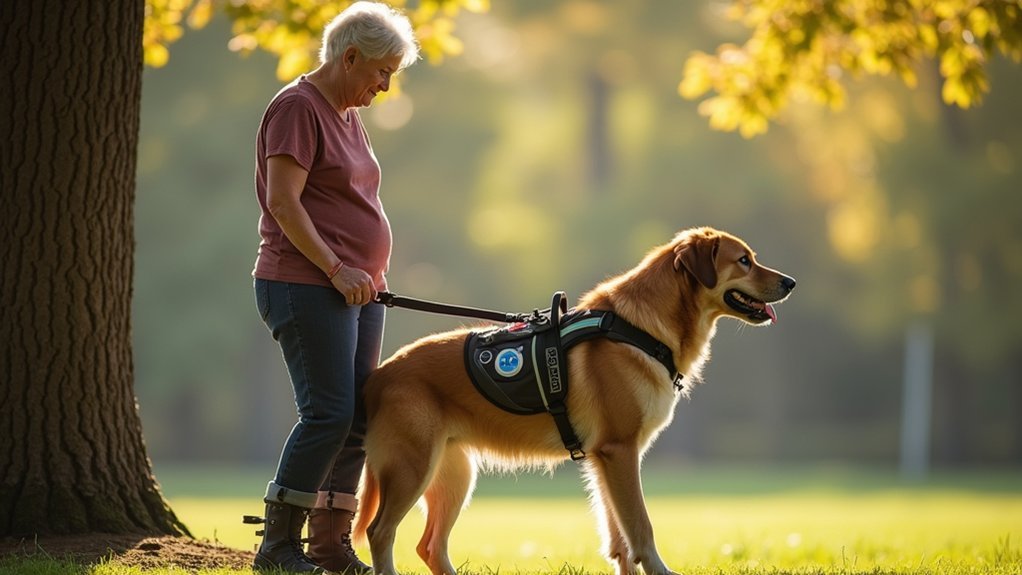
Four essential ways mobility service dogs provide physical support transform daily life for individuals with mobility challenges.
Through counterbalance techniques, these dogs use their body weight against your harness, offering resistance that improves your stability while walking or standing.
A dog’s counterbalance transforms mere steps into confident strides, creating resistance that grounds your movement through shared stability.
They can brace you in seated positions by leaning against you, creating tension that supports upright posture and provides abdominal compression for extended sitting periods.
When you’re standing, your dog can lean against your leg to help maintain balance and prevent falls. This support extends to crouching or transferring between positions.
Additionally, the sensory feedback you receive through touching your dog’s shoulder or harness enhances your spatial orientation and stability.
These physical connections provide reliable anchor points that increase your confidence and independence in daily movement. For individuals who cannot use traditional mobility devices like canes or walkers, these specially trained service dogs become an essential alternative support system.
Retrieving Essential Items for Limited Mobility
Your mobility service dog can retrieve dropped items from the floor and place them directly into your hand, eliminating risky bending or reaching movements.
They’re trained to fetch specific objects like medication bottles from lower cabinets when you can’t access them yourself.
These floor-to-hand retrievals and medicine cabinet access skills greatly enhance your independence while reducing physical strain throughout your daily routine. Through consistent positive reinforcement and training, dogs can learn to retrieve objects with increasing reliability and precision.
Floor-to-Hand Retrievals
Dropping your phone or medication when you have limited mobility can transform a minor inconvenience into a major challenge. Mobility service dogs excel at retrieving these essential items from the floor, placing them directly into your hand without you needing to bend or strain.
These highly trained companions—often Golden Retrievers, Labradors, or Poodles—respond quickly to commands, picking up keys, remote controls, and other daily necessities. This skill considerably reduces your risk of falls while enhancing your independence.
Beyond the practical benefits, floor-to-hand retrievals allow you to maintain your daily routine without constantly asking others for help.
You’ll notice improved confidence and greater participation in social activities as you’re able to handle dropped items independently. Research shows that these retrievals decrease performance time and require less effort compared to completing the task without assistance. This single skill dramatically impacts your safety, autonomy, and quality of life.
Medicine Cabinet Access
Retrieving medication from high cabinets presents a significant challenge for individuals with mobility limitations. Mobility service dogs are specifically trained to access these essential items, helping you maintain independence in your daily health routines.
These canine assistants undergo approximately 18 months of specialized training to identify and carefully retrieve medications, inhalers, or first-aid supplies.
Your service dog can dramatically improve your quality of life by:
- Reducing reliance on caregivers for accessing essential health items
- Enhancing medication adherence through timely access
- Minimizing physical strain from reaching or bending
- Providing peace of mind during medical emergencies
- Strengthening your sense of confidence and dignity
With consistent commands and proper cabinet organization, your service dog becomes an invaluable partner in managing your health needs while promoting greater independence and safety. The cost for training these specialized mobility service dogs typically ranges from $7,000 to $30,000, reflecting the extensive skills they must develop to assist with medication retrieval and other tasks.
Opening Doors and Navigating Physical Barriers
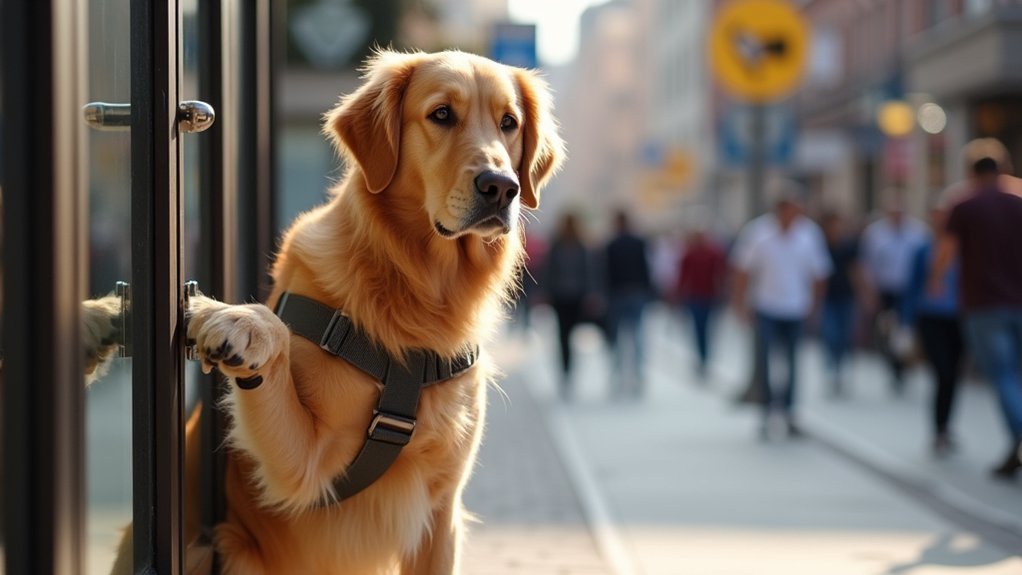
While most people take opening a door for granted, this simple task presents significant challenges for individuals with mobility impairments. Mobility service dogs excel at removing these barriers by physically opening and closing doors using their mouths or paws to pull handles or press automatic door buttons.
Your service dog can also press elevator controls and handicap access buttons that might be out of your reach. They’ll retrieve keys or access cards needed for locked entrances and provide balance support when you encounter stairs, curbs, or uneven terrain.
Beyond assistance with doors, these dogs offer counterbalance support while walking, can pull wheelchairs up inclines, and create physical barriers in crowded spaces. Service dogs are carefully trained to pick up objects that have fallen or are otherwise inaccessible to their owners.
This thorough support reduces your dependence on human assistance and builds confidence for community participation.
Assistance With Daily Tasks and Routines
For individuals with mobility limitations, everyday tasks that others take for granted can present significant challenges. Your mobility service dog can become an essential partner in completing daily routines with greater independence.
These highly trained companions can retrieve dropped items like phones or remotes, fetch medications or water when needed, and help with household tasks that would otherwise require bending, stretching, or maintaining difficult positions. They can also provide counter-balance support when walking to prevent falls and maintain stability.
- Retrieves essential items from other rooms when mobility is limited
- Assists with laundry by fetching clothes or moving items
- Helps maintain independence in the kitchen by retrieving utensils
- Supports activities requiring physical stability like showering
- Enhances your ability to engage in outdoor activities with confidence
Your service dog transforms potentially frustrating situations into manageable ones, allowing you to maintain both independence and dignity throughout your daily routine.
The Psychological Benefits of Mobility Service Dogs
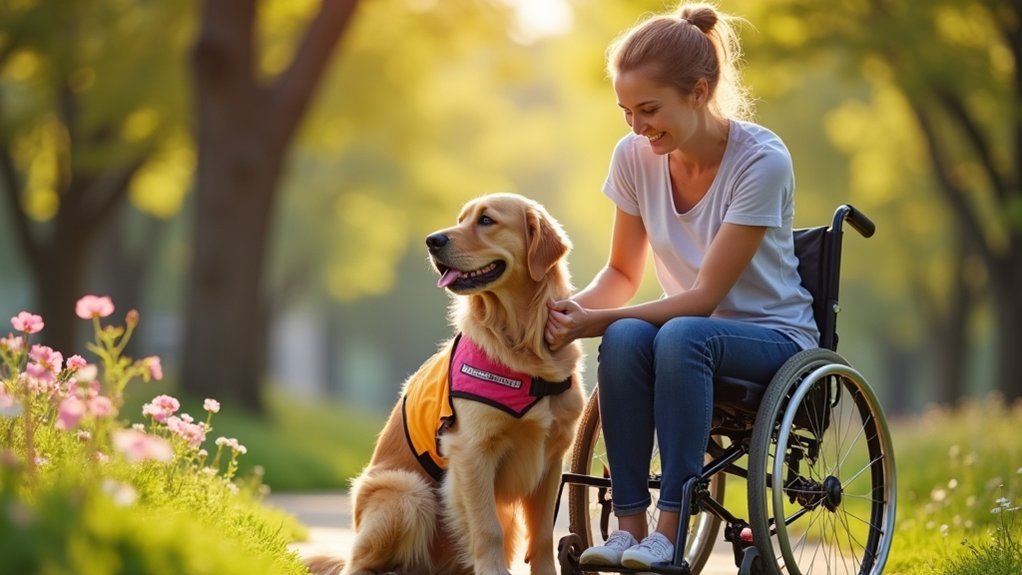
Beyond their physical assistance capabilities, mobility service dogs offer profound psychological benefits that greatly impact their owners’ mental wellbeing.
These canine companions considerably reduce feelings of isolation and loneliness while providing consistent emotional support when you need it most. Regular interaction with these dogs can alleviate symptoms of PTSD and anxiety effectively for veterans transitioning to civilian life.
You’ll likely experience enhanced social functioning as your service dog acts as a natural conversation starter, breaking down social barriers and facilitating meaningful interactions.
The visible presence of your dog often encourages others to engage with you in public settings.
The emotional bond you’ll develop with your service dog contributes to improved self-esteem, emotional stability, and overall quality of life.
This connection fosters a sense of security and empowerment that extends into daily activities, helping you feel more confident and independent despite physical limitations.
Training Requirements for Specialized Mobility Tasks
Transforming a dog into an effective mobility service animal involves rigorous, multi-faceted training that extends far beyond basic obedience.
Your future service dog will master tasks specifically tailored to your mobility limitations, whether it’s pulling your wheelchair, providing balance support, or helping with dressing.
What sets mobility service dogs apart is their ability to act independently during emergencies. They’ll learn to recognize when you need help without commands—a critical skill if you fall or become disoriented.
Many trainers begin working with puppies as young as 8 weeks old to establish the foundation for future specialized tasks.
- Dogs undergo orthopedic screening to verify physical capability
- Training includes both handler-cued and autonomous task performance
- Advanced techniques like clicker training help teach complex mobility tasks
- Dogs learn to ignore distractions while focusing solely on your needs
- Regular certification testing verifies skills remain sharp and reliable
Legal Rights and Public Access for Mobility Service Teams
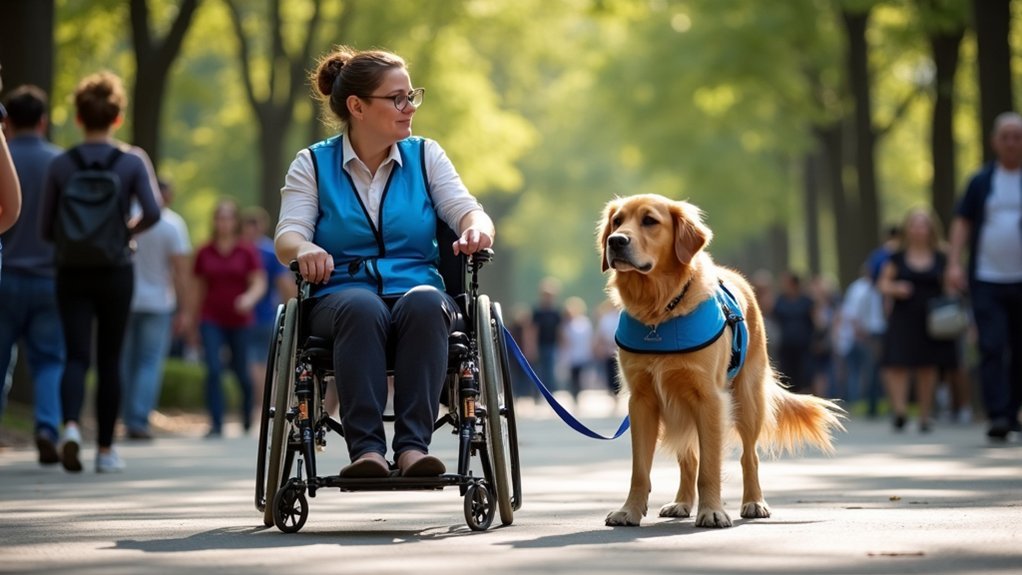
Three fundamental legal frameworks protect your rights as a mobility service dog handler. The Americans with Disabilities Act guarantees your service dog’s access to public spaces including businesses, government facilities, and transportation. Unlike emotional support animals, properly trained mobility service dogs can’t be denied entry if they’re under control and housebroken. In Louisiana, businesses may only ask if the animal is a service dog and what specific tasks it performs, but cannot request documentation or inquire about your disability.
| Access Right | Legal Protection |
|---|---|
| Public Businesses | ADA Title III |
| Government Facilities | ADA Title II |
| Housing | Fair Housing Act |
| Transportation | ADA & DOT Regulations |
| Hotels & Lodging | ADA Title III |
Choosing the Right Mobility Service Dog Breed
When selecting a mobility service dog, you’ll need breeds with adequate size and strength like Labrador Retrievers, Golden Retrievers, or German Shepherds that can support your physical needs.
Your ideal companion must have the right temperament—calm, intelligent, and responsive—while remaining stable in various environments and situations.
Beyond breed characteristics, you should also consider your lifestyle, living arrangement, and specific mobility requirements to guarantee the perfect match for your long-term partnership.
For pulling and walking support tasks, ensure your service dog meets the minimum size requirements of 22 inches in height and 55 pounds in weight to safely perform these physically demanding duties.
Best Breeds for Support
Selecting the ideal breed for mobility assistance requires careful consideration of both physical capabilities and temperament traits.
When evaluating your options, you’ll find certain breeds consistently excel in service work due to their intelligence, stability, and physical attributes.
- Labrador Retrievers combine intelligence, trainability, and strength for complex mobility tasks.
- Golden Retrievers offer patience and steady support, ideal for handlers needing gentle assistance.
- German Shepherds provide confident, focused support with exceptional problem-solving abilities.
- Standard Poodles bring versatility and longer working lifespans with quick learning capabilities.
- Collies deliver thoughtful assistance with remarkable ability to anticipate handlers’ needs.
Each breed brings unique strengths to mobility support, so match your specific requirements with the breed’s natural tendencies for the most successful partnership. Successful service dogs require a medium-to-large size to effectively perform tasks like opening doors and providing physical stability.
Size and Strength Matters
The correct size and strength of a mobility service dog directly impact their effectiveness and safety in performing assistance tasks. For most mobility work, dogs should stand at least 22 inches tall and weigh a minimum of 55 pounds, with wheelchair-pulling tasks requiring 65-70 pounds.
Your dog’s size should be proportional to your needs—if you weigh over 130 pounds, your service dog should be at least 60 pounds. For brace work, your hand should fall within 6-8 inches of your dog’s withers. General guidelines suggest that a dog should weigh approximately 50% of handler’s weight for effective bracing tasks.
Golden Retrievers, Labradors, and German Shepherds offer ideal combinations of size, strength, and longevity.
Remember that even properly-sized dogs can’t support your entire weight—they provide assistance rather than total support. The right size guarantees both your safety and your dog’s well-being.
Temperament Considerations
Beyond physical attributes, a mobility service dog’s temperament forms the foundation of their effectiveness as an assistance partner. When selecting a service dog candidate, you’ll want to prioritize temperament over breed specifics.
Look for dogs that demonstrate calmness in stressful situations and maintain focus despite distractions.
The ideal mobility service dog exhibits:
- Unwavering focus on you regardless of environmental distractions
- Calm, stable reactions to unexpected events or loud noises
- Natural responsiveness to commands without excessive repetition
- Adaptability to various social settings and public environments
- Self-control and patience when faced with challenging situations
Bernese Mountain Dogs and certain Poodle mixes often excel in these areas, though individual assessment matters more than breed.
A dog’s trainability and ability to form a devoted bond with you ultimately determines their success in mobility support roles. The most effective service dogs consistently demonstrate an eager to please attitude toward their handlers.
Building Independence Through Canine Assistance
Specially trained mobility service dogs transform the lives of individuals with physical limitations by performing essential tasks that might otherwise require human assistance. Your service dog can open doors, push elevator buttons, and operate light switches, giving you newfound autonomy in maneuvering your environment.
These canine partners help with daily activities like dressing and undressing, or assisting you in and out of baths. In emergencies, they’ll pull wheelchairs or carry packages. Service dogs provide critical emotional support that enhances your psychological well-being in ways that medical devices cannot.
Studies show service dogs reduce unpaid assistance hours by approximately 64%, markedly decreasing the caregiving burden on family and friends.
Beyond practical assistance, your service dog enhances your overall quality of life by increasing independence and reducing stress associated with caregiving needs. This support empowers you to manage your daily life with greater dignity and self-sufficiency.
The Social Connection Advantages of Service Dogs
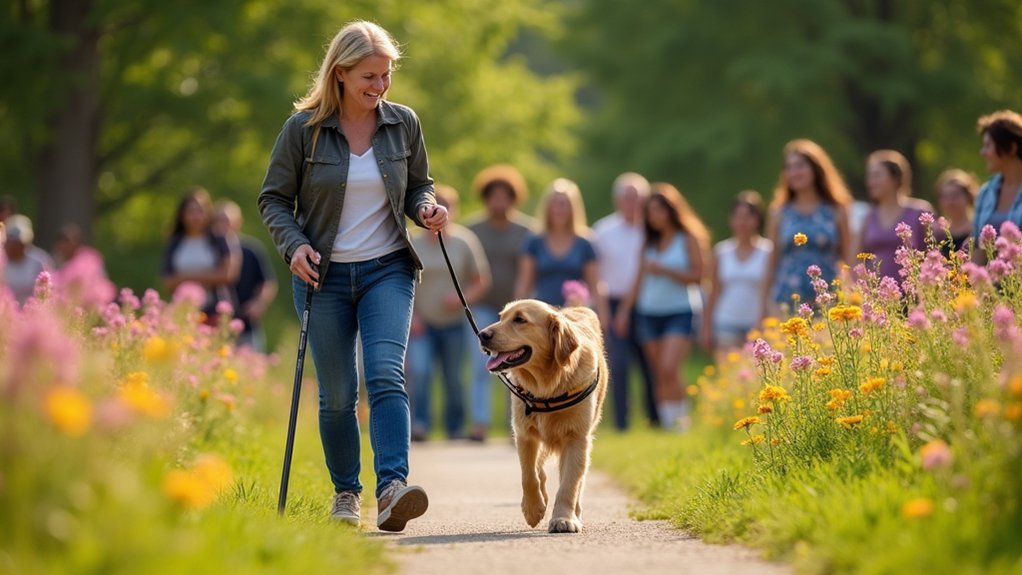
When you’re accompanied by your mobility service dog, you’ll notice how they effortlessly break down social barriers that might otherwise exist.
Your canine partner often serves as a natural conversation starter, shifting interactions away from your disability toward genuine connection.
These social bridges help you navigate community spaces with greater ease, transforming potentially awkward encounters into meaningful exchanges. Many individuals with disabilities report feeling less socially isolated when their service dog accompanies them in public settings.
Breaking Social Barriers
Although mobility assistance remains their primary function, service dogs provide profound social benefits that transform the lives of individuals with disabilities. Your service dog serves as a powerful catalyst for social connections, helping you overcome barriers that often isolate people with mobility challenges.
With a service dog by your side, you’ll notice:
- Increased confidence in public settings, making social interactions less intimidating
- More frequent positive interactions with strangers who approach to inquire about your canine partner
- Reduced feelings of isolation as your dog creates natural opportunities for conversation
- Greater community integration through improved access to public spaces
- Enhanced self-esteem that empowers you to participate more fully in social activities
These social advantages extend far beyond physical assistance, creating pathways to meaningful human connections.
Conversations Beyond Disability
Service dogs create remarkable social bridges, transforming casual interactions into meaningful connections that transcend disability-focused conversations. You’ll find your companion shifts the focus from limitations to shared interests as people approach to admire your dog.
| Social Benefit | Real-World Impact |
|---|---|
| Conversation Starter | People approach with curiosity about your dog rather than awkwardness |
| Focus Shift | Discussions evolve beyond disability to common interests and experiences |
| Community Integration | Regular interactions at parks and shops build neighborhood connections |
| Confidence Boost | Your increased social presence strengthens communication skills |
With your service dog by your side, you’ll experience reduced social stigma and increased community participation. Rather than isolating, your mobility companion opens doors to relationships where you’re seen as a person first—someone with valuable perspectives to share.
Adapting Service Dog Training to Individual Mobility Needs
Because each person’s mobility challenges differ markedly, effective service dog training must be tailored to address specific needs and circumstances.
You’ll need a thorough assessment of your mobility limitations to prioritize the most beneficial tasks for your service dog. Training incorporates your specific environment, lifestyle, and daily routines.
- Wheelchair users receive specialized instruction for commanding dogs while seated
- Public access training includes 30+ hours in various community settings
- Dogs learn task-specific commands based on your unique mobility requirements
- Training adapts as your mobility needs evolve over time
- Family members can participate in training to guarantee consistent handling
Our trainers employ positive reinforcement techniques throughout the mobility service dog training process to create a supportive learning environment that enhances success. Safety remains paramount when designing your dog’s training program, with ongoing evaluation to verify tasks remain appropriate as your mobility needs change.
Frequently Asked Questions
How Long Does Mobility Service Dog Training Typically Take?
Your mobility service dog will typically need at least 120 hours of training spread over 6 months to 2.5 years. The average training period lasts about 18 months, including 30 hours in public settings.
What Happens to Mobility Service Dogs When They Retire?
When your mobility service dog retires, they’ll typically remain with you as a pet. If you can’t keep them, specialized organizations help rehome them. The change includes emotional support for both you and your dog.
How Much Does Obtaining a Mobility Service Dog Cost?
You’ll spend between $15,000-$30,000 for professionally trained mobility service dogs, though costs can reach $50,000. If you self-train, you’ll pay $0-$7,000, while hybrid training approaches cost $7,000-$15,000.
Can Children With Mobility Impairments Receive Service Dogs?
Yes, your child with mobility impairments can qualify for a service dog. You’ll need a medical professional’s assessment to determine eligibility. These dogs are specifically trained to assist with your child’s unique mobility needs.
How Do Mobility Service Dogs Handle Emergency Medical Situations?
Your mobility service dog can fetch medical supplies, alert others for help, pull your wheelchair to safety, help you get up after falls, and keep you calm during emergencies. They’re trained for crisis response.
In Summary
When you partner with a mobility service dog, you’re gaining more than physical assistance—you’re embracing a new level of independence. Your canine companion won’t just help with balance, retrieving items, or maneuvering around obstacles; they’ll transform your daily routine and social connections. Whether you’re managing a permanent disability or temporary limitation, your service dog adapts to your unique needs, becoming an essential part of your mobility journey.





Leave a Reply